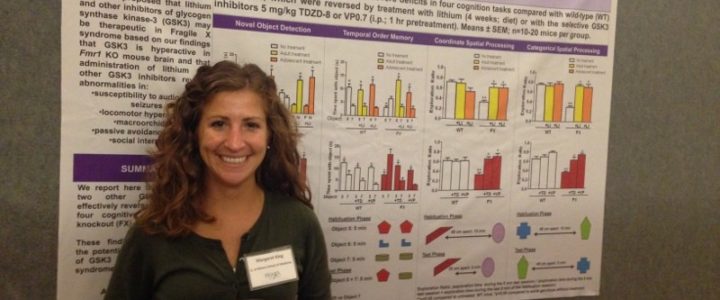Dr. Jongens and his collaborators have found an insulin-like protein in the fly brain that is overexpressed in the Fragile X mutant fly, leading to increased activity of the insulin signaling pathway. Furthermore, they found that certain behavioral patterns in the Fragile X flies can be rescued by expressing the FX gene just in insulin producing neurons in the fly brain. In the mutant, there are other changes in the signaling pathways, including a decrease in cAMP and elevation in PI3K, mTOR, Akt and ERK activity. They now propose to study 2 medicines used for diabetes: pioglitazone (increases cAMP and decreases Akt and ERK) and metformin (inhibits mTOR), in flies and mice to validate the potential efficacy of these novel therapeutics for Fragile X.
Read moreResearch
Analysis of Developmental Brain Dysfunction in Families

FRAXA Research Foundation is proud to make a grant of $90,000 over 2014-2015 to Margaret King, PhD. The goal of this project is to identify new approaches to clinical trial design for Fragile X pharmaceuticals.
Read moreFRAXA Grant to Nahum Sonenberg, PhD — Effects of metformin in Fmr1 knockout mouse model of Fragile X syndrome

Mis-regulation of activity-dependent protein synthesis is one of the major cellular abnormalities found in Fragile X. Upstream neuronal signaling regulates a large cluster of enzymes called the mTORC1 complex, which in turn regulates protein synthesis. This complex is also controlled by cellular energy levels via the metabolic sensor AMP-activated Protein Kinase (AMPK). AMPK is a highly conserved kinase that is activated under conditions of energy stress, when intracellular ATP levels decline and intracellular AMP increases.
Read moreThe Endocannabinoid System in a Mouse Model of Fragile X Syndrome

With a $128,500 grant over 2011-2013 from FRAXA Research Foundation, Drs. Bradley Alger and Ai-Hui Tang at the University of Maryland researched endocannabinoid pathways in Fragile X.
Read moreInhibitors of STEP as a Novel Treatment of Fragile X Syndrome

With a $349,000 grant from FRAXA Research Foundation from 2008-2015, Dr. Paul Lombroso and his team at Yale University researched if inhibiting STEP could reduce behavioral abnormalities in Fragile X syndrome. Results published.
Read moreMolecular Mechanisms of Cytoskeletal Regulation by FMRP

With a 2-year, $120,000 grant from FRAXA Research Foundation in 2015, Dr. Samie Jaffrey from Weill Medical College of Cornell University will research the connection between FMR1, RhoA, and dendritic spine abnormalities.
Read moreTargeting the Endocannabinoid System in Adult Fragile X Mice

With a $90,000 grant from the FRAXA Research Foundation from 2013-2014, Dr. Andres Ozaita led a team to test rimonabant’s ability to blockade the CB1 receptor. Blocking CB1 has shown potential to reverse most symptoms of disease in mice bred to mimic Fragile X syndrome.
Read morePhase 1 Clinical Trial of Mega Green Tea Extract in Fragile X Syndrome

With a $124,000 grant from the FRAXA Research Foundation from 2012-2014, Dr. Mara Dierssen and Dr. Rafael de la Torre conducted preclinical studies in Fragile X knockout mice and a clinical trial in Fragile X patients using Mega Green Tea Extract, which contains 45% by weight epigallocatechin gallate (EGCG).
Read moreFunctional Interplay Between FMRP and CDK5 Signaling
With a $180,000 grant from the FRAXA Research Foundation over 2011-2014, Dr. Yue Feng and Dr. Wenqi Li at Emory University will study CDK5 pathway function and regulation in an effort to break down whether and how CDK5 signaling is affected by the loss of the Fragile X protein, FMRP, in the Fragile X mouse model.
Read moreComputational Analysis of Neural Circuit Disruption in Fragile X Model Mice

Computer modeling of the brain offers the hope of predicting how the brain responds to varying conditions, but these models have been rather primitive until recently. The Sejnowski team at the Salk Institute, who specialize in computational models of neural networks, will take the results of previous FRAXA-funded projects and incorporate them into their advanced computer models of brain function.
Read moreSynaptic Characterization of Human Fragile X Neurons

With a $90,000 grant from FRAXA Research Foundation over 2013-14, Dr. Marius Wernig and Dr. Samuele Marro at Stanford analyzed homeostatic plasticity and regulation of synaptic strength by retinoic acid. If the results are encouraging, they will move forward with testing whether available RA antagonists can alleviate observed abnormalities in these cells.
Read moreBcl-xL Inhibition as a Therapeutic Strategy for Fragile X Syndrome

Scientists have found increases in the numbers of neurons in brain regions of autistic children, suggesting a problem in developmental programmed cell death pathways. One of the most important effectors of neuronal survival during brain development is the “anti-cell death” protein Bcl-xL. While the normal function of Bcl-xL is to maintain a healthy number of neurons and synapses, over-expressed Bcl-xL can cause an overabundance of synaptic connections. This may be happening in Fragile X.
Read moreSeizures in Fragile X Syndrome and Therapeutic Potential of NMDA Receptor Antagonists

With a $90,000 grant from the FRAXA Research Foundation, Dr. Robert Wong is investigating how seizures are generated in Fragile X neurons. More generally, he is looking at how synapses are modified to enable learning and memory and how this process is impaired in Fragile X.
Read moreSmall Molecules To Target r(CGG) Expansions to Treat Fragile X Syndrome

With a 2-year, $90,000 grant from FRAXA Research Foundation, Dr.’s Matthew Disney and Wang-Yong Yang worked to correct the underlying problem in Fragile X: the silencing of the Fragile X gene (FMR1) and the resulting lack of FMRP (Fragile X Mental Retardation Protein). Their approach was to use novel small molecules to target the abnormal CGG repeats before the FMR1 gene.
Read morePotassium Channel Modulators to Treat Fragile X

With $246,000 in funding from FRAXA over 2012-2014, the Yale University team of Leonard Kaczmarek, PhD, showed that loss of FMRP leads to an increased Kv3.1 potassium currents and decreased Slack potassium currents in neurons. Both of these changes impair timing of action potentials in auditory neurons (and likely others throughout the brain). The team also found that the firing pattern of neurons in response to repeated stimulation is severely abnormal in Fragile X mice. Based on these results, they are collaborating with the UK-based company Autifony to develop and test advanced compounds which may reverse these deficits.
Read moreSocial Behavior as an Outcome Measure for Fragile X Clinical Trials

One of the features of the Fragile X mouse model which is relevant to the human Fragile X syndrome (and autism) is social behavior. Several tests show consistent social behavioral abnormalities in the Fragile X mouse model. With a $140,000 grant from FRAXA Research Foundation in 2012-2013, Dr. Willemsen at Erasmus University used social behavior tests to measure the effectiveness of several drug strategies.
Read moreTranslation-Independent Functions of FMRP in Excitability, Synaptic Transmission and Plasticity

With a $140,000 grant from FRAXA Research Foundation, Dr. Vitaly Klyachko and team at Washington University explored STP (short-term plasticity) in Fragile X, namely looking at presynaptic calcium dynamics as a major underlying cause of the STP defects.
Read moreGlycogen Synthase Kinase-3 (GSK3), Lithium and Fragile X

With $208,000 in funds from FRAXA Research Foundation, Dr. Richard Jope and his team at the University of Miami tested whether newly developed, highly specific inhibitors of GSK3 can reduce behavioral abnormalities in Fragile X mice.
Read moreDevelopment of a Novel GABA-A Agonist in Fragile X Syndrome

Of the many genes known to be regulated by FMRP, the gamma-aminobutyric acid receptor A (GABA(A)), is gaining attention as a potential target for the treatment of FXS. Mounting evidence suggests decreased expression and functioning of GABA(A) is involved in the pathophysiology of FXS. Non-selective GABA(A) agonism in animal models of FXS has been associated with normalization of morphological features, GABA(A) expression, and behavior. However, the clinical use of these agents in Fragile X is associated with unwanted side-effects, such as sedation, dulling of cognition, and occasional paradoxical agitation, which limits their use.
Read moreThe mTOR Pathway in Fragile X Syndrome
With a $90,000 grant from FRAXA Research Foundation over 2012-2013, Dr. Eric Klann and Postdoctoral Fellow Dr. Aditi Bhattacharrya of New York University investigated alterations in the mTOR pathway in Fragile X syndrome – which is also known to be defective in several forms of autism. Their work was published in September 2012 and received international attention.
Read moreMatrix Metalloproteinase Therapeutic Treatments for Fragile X Syndrome

With a $157,000 grant from the FRAXA Research Foundation in 2012-2013, Dr. Kendal Broadie and Dr. Cheryl Gatto worked to define the distinct but also overlapping roles for MMP-1 and MMP-2 in synaptic structural and functional development. In drug studies with Fragile X fruit flies, they will be testing a range of MMPIs in drug treatments to compare effectiveness during development and at maturity, in order to define the contributions of FXS developmental impairments and adult recovery/plasticity.
Read moreLovastatin Discovery in Fragile X Mice Leads FRAXA to Fund Clinical Trials

Dr. Emily Osterweil was awarded the FRAXA Pioneer Award at the opening dinner of the 2011 FRAXA Investigators Meeting in Southbridge, MA for her work demonstrating that Lovastatin could treat Fragile X. Dr. Osterweil conducted her experiments in the MIT laboratory of Dr. Mark Bear and has since established her own laboratory at the University of Edinburgh. The team discovered that lovastatin, a drug widely prescribed for high cholesterol, can correct excess hippocampal protein synthesis in the mouse model of FXS and can prevent epileptogenesis. The work is published in the prestigious neuroscience journal Neuron: Lovastatin Corrects Excess Protein Synthesis and Prevents Epileptogenesis in a Mouse Model of Fragile X Syndrome.
Read moreEffects of minocycline on vocal production and auditory processing in a mouse model of Fragile X

With $135,000 in grants from FRAXA Research Foundation over several years, Dr. Khaleel Razak and Dr. Iryna Ethell explored robust biomarkers relevant to the FXS and the efficacy of minocycline treatment.
Read moreEndocannabinoid Mediated Synaptic Plasticity in Fragile X Mice

With a $90,000 grant from FRAXA Research Foundation over two years, Drs. Olivier Manzoni and Daniela Neuhofer researched the relationship between Fragile X syndrome and the areas of the brain that are involved in reward processing, regulation of emotional behavior and emotional memory as well as attention, planning and working memory.
Read moreDeveloping IPS cells to Screen Drugs which can Reactivate the FMR1 Gene

With $146,000 grant from FRAXA Research Foundation over 2012-2013, Drs. Anita Bhattacharyya and Xinyu Zhao at the University of Wisconsin developed a new mouse model of Fragile X syndrome which will enable testing of gene reactivation and gene therapy approaches to treatment. They transplanted human Fragile X neural cells differentiated from induced pluripotent stem cells into brains of neonatal mice and then testing for FMR1 reactivation. In 2015, The John Merck Fund assumed support for this work with a generous grant of $750,000 to the scientists. Results published.
Read more
